Over the past few years, BJJ Heroes has dedicated much of its space to finding the trends of modern-day jiu-jitsu, by publishing and analyzing the data from many of our top sports tournaments. For obvious reasons, the ADCC has been one of our most addressed events with our coverage of the promotion’s World Championships leading to overall data assessments such as the “After Math” reports (click here for last year’s analysis), as well as more in-depth articles on the Importance Of Wrestling In The ADCC, the Importance Of Heel Hooks In The ADCC, Team vs Team articles, to name a few.
One subject that remained an open question over the past few years was the female division’s dynamics. Although our latest analytics coverage did include the female division, an overall, stand-alone, data compilation was yet to be done due to the smaller data pool available at these shows, which feature solely 16 female matches (at the World Championship stage) as opposed to the 96 found in the male division.
Having meticulously followed the past 4 events of the ADCC World Championships, we have 62 female matches thoroughly dissected and have enough data to release the findings below.
IN GUARD WE TRUST
One of the most curious facets of female jiu-jitsu, and one that certainly sets it apart from the conventional approach observed in men, is the guard. While past data has consistently shown us that the guard is a borderline afterthought under the ADCC ruleset, female jiu-jitsu athletes have completely twisted that dogma around. As per our first graph, sweeping is the most utilized form of advancing position in a match among women:
Top 3 Most Utilized Scoring Positions In The Female ADCC Division (2015-2022):
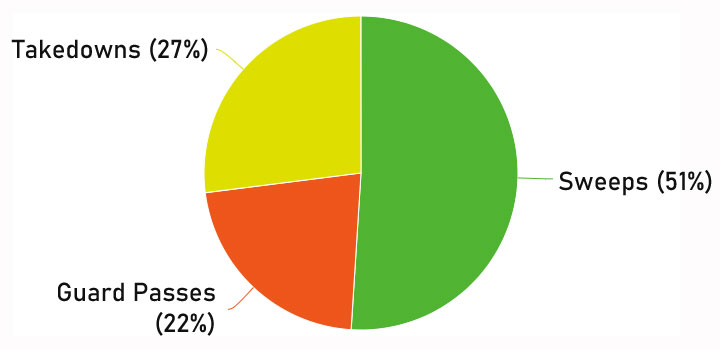
Another idiosyncratic approach to the guard game in the women’s grappling division are the sweeping techniques applied. Away from the dominance of the wrestle-up approach so commonly used in previous assessments of the guard here the data shows a more traditional approach to guard playing, with the butterfly hook sweep at the helm of these scoring positions.
Top 3 Most Utilized Sweeps In The Female ADCC Division (2015-2022):
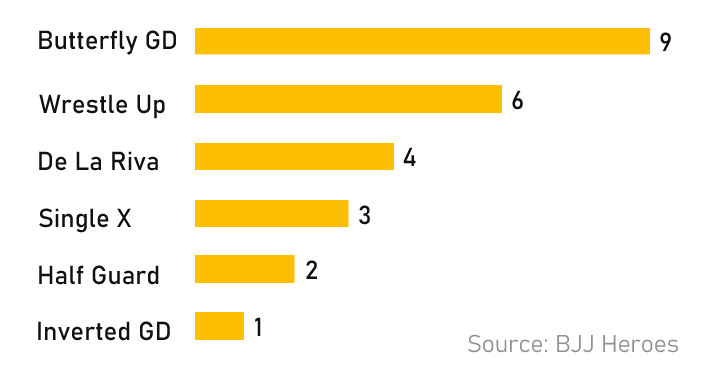
Also worthy of note is the use of the De La Riva Guard, which led to 1 Berimbolo entry to sweep and 3 very classical overhead sweeps. movements that had not been recorded previously.
Continuing on our deep dive into the guard, we can also see how the guard retains its value when taking the back. In previous analyses we had reported on how only 17% of back takes in the male division had come from guard attacks, but the degree of technical guard work performed by female athletes shows much-improved numbers on this front.
There is no real explanation as to why the guard is more prevalent in this division aside from the fact that so many guard specialists were a fundamental part of the ADCC roster over the past 4 editions of the show. Athletes like Mackenzie Dern, Beatriz Mesquita, Tammi Musumeci, Ana Laura Cordeiro, Michelle Nicolini, to name a few.
This peculiar aspect of the female division may be fading away, however, when looking at each year’s data, individually. Despite big numbers of sweeps and back takes from the guard, as well as low numbers of takedowns in the past, the new breed of women is changing these stats in a fairly big way. This past edition of the world championship (ADCC 2022) saw a record-high number of takedowns (8), a record number of back-takes from takedown attempts – shattering previous records (4), and zero (0) back takes from the guard (also a record, but from a bottom of the line perspective).
LEG LOCKS DON’T WORK
On the submission front, things remain interesting for this report. Although we wouldn’t want to fall on the repetitiveness of making comparisons between the two genders, some statistical differences jump at us like a sore thumb.
On average, the female division provided more submissions than those observed in the males by 7 percentage points, with a 37% submission rate across the 4 tournaments versus the 30% found in the male category. Although this is an element worthy of note, this is not the most interesting detail.
Most Utilized Submissions In The Female ADCC Division (2015-2022):
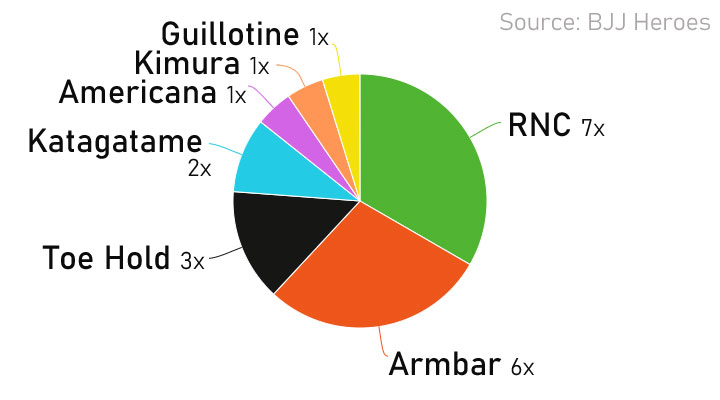
As you can see, the lack of lower limb submissions may be quite surprising to a few of you who have been following our reports over the years. Although lower limb submissions have historically scored below the 30% of the overall submission rate, the female division shows less than half those numbers at 13%.
Another incredible number – or lack thereof – is that zero (0) heel hook submissions were found. For reference, our last ADCC study (based on male div.) had shown how the heel hook had consistently ranked as the #2 and #3 most successful submission in the male division over the past 3 editions of the tournament. In the female category, it was nowhere to be found.
We can only speculate as to why female athletes have not had as much success with this maneuver. Women are, generally speaking, more flexible than men and usually have smaller feet, making these attacks harder to perform. It is also fair to say that the majority of female ADCC-level players have more traditional jiu-jitsu games and are less prone to the leg-spaghetti styles so often seen in sub-only events. Athletes like Amy Campo, Gabrielle Garcia, Bia Mesquita, Ffion Davies, Brianna Ste.-Marie, etc, all play very positional dominant games which could very well be a feature for the non-existence of heel hooks, and not the bug.
TOP SUBMISSION ARTISTS IN THE DIVISION
Hardly anyone in the ADCC has had more success with submissions than Bia Mesquita. The talented lightweight struggled with the ruleset in her first campaign back in 2015, taking two unexpected losses but bounced back in 2017 for her most dominant performance to date with all wins coming via submission.
Although Mesquita has not found her way back into another gold medal, her submission hunting skills remain very much alive, as shown at the latest edition of the tournament where she earned another.
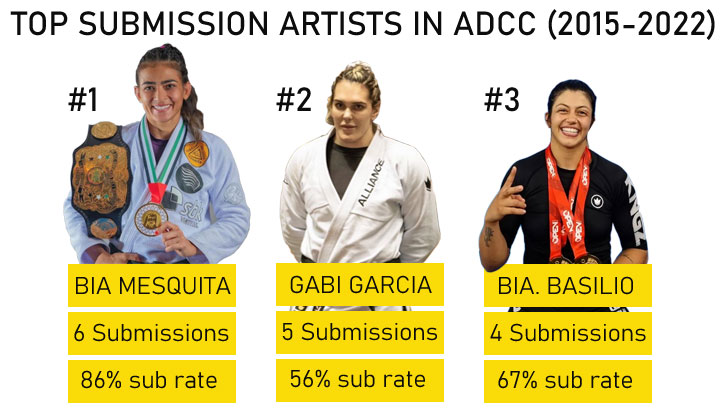
Links for top 3 athletes’ records and bios:
#1. Beatriz Mesquita
#2. Gabrielle Garcia
#3. Bianca Basílio
IS THE TOP GAME THE BEST GAME?
As alluded to in past analyses of the biggest grappling show on earth, the ADCC, the event’s previously assessed dynamics had outlined the most common path to victory as such: Establishing top position, keeping it, and improving on it by passing the guard or by forcing the bottom player to turtle to secure back points/submission. This, however, is not as prevalent in the female division, which is understandable, if we take into consideration that (as seen above) the use of the guard is much more widespread here.
The successful takedown rate of 33% observed in the women’s division is substantially lower than that of the men’s 46% average and guard passing is also lower in overall numbers, though not by a long margin.
Interestingly, though, both the average of takedowns and guard passes seem to be trending upwards, which may be a sign of how the new generations are following a different route from the heroes of past events.
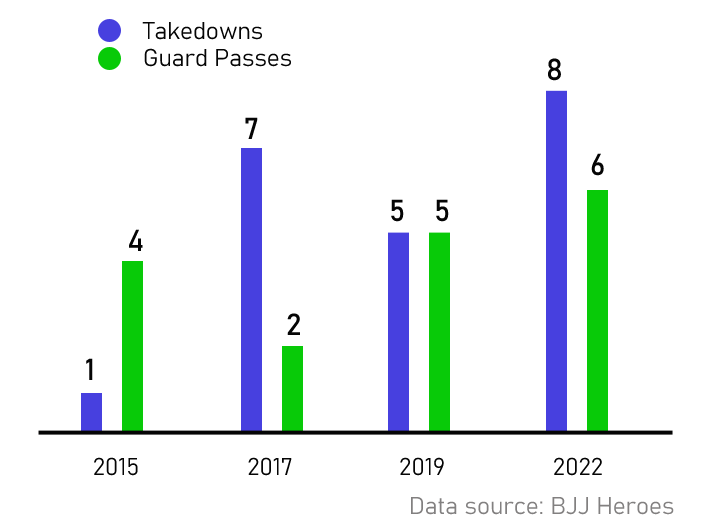
When it comes to guard-passing the numbers could not be clearer, close range champions any other style of approach. Controlling the hips is an absolute must when passing slippery and flexible guards and this is exactly what we see over and over again at this level.
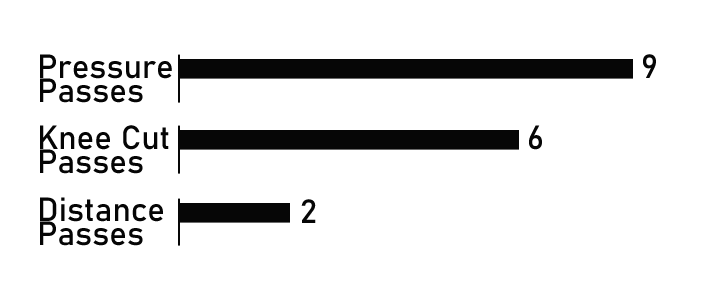
The top guard passer in the division is Ffion Davies. The Welsh star and her killer knee-cut pass dominated this metric, finding success 5 times, with the only person that came close(ish) being Ana Laura Cordeiro (3x).
When separating the under 60 kilograms and the +60 kilogram divisions, the differences are not worthy of note, with similar numbers in guard-passes and similar numbers of takedowns.
CONCLUSION
When addressing the female division at a macro level, taking note of the number of instances (successful positions conquered in a match) found there, we can have a clearer picture of which style dominates.
Percentages of Instances Conquered In The Female ADCC Division (2015-2022):
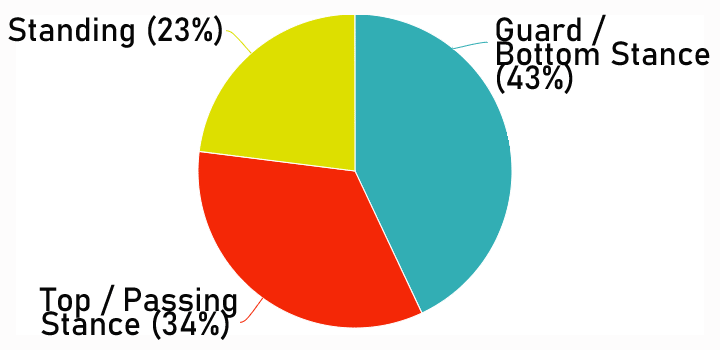
The graph above shows the combined results of every successful position conquered in all the matches observed in the women’s division, sweeps, passes, takedowns, back takes, submissions, etc. Meaning, where these instances originated from. In it, we see the guard as the dominant force when trying to advance position. Nevertheless, top players have had tremendous success over the years.
One quick look and you will see predominantly top players like Bianca Basílio, Ffion Davies, Gabrielle Garcia, or Ana Laura Cordeiro, and the havoc they have had in their weight classes.
Nothing is ever set in stone, and trends are broken at every competition. That said, this large-scale analysis does put guard playing at the top of the pyramid for ADCC success at this moment in time in the female category of the ADCC.
The original cover photo was taken by Mike Calimbas. Follow Mike on social media at @mikecalimbas
















This is awesome, thank you for doing an analysis for the woman’s division!! I’ve been training for a couple of years now and am currently getting into the world of data analysis. I’ve been looking up jiu jitsu datasets on kaggle, but the only dataset for ADCC I could find was pretty bare. Any suggestions?
Love seeing stats on the women’s division! I got a heel hook finish in Chicago 2023 in Masters women -70kg intermediate division.